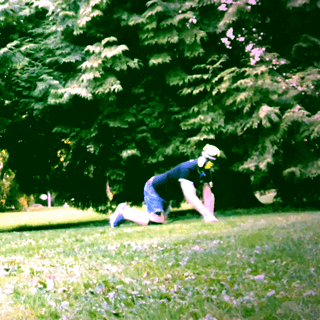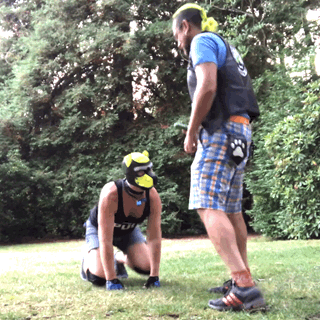 Training the human pup is not entirely different than training a canine pup. It requires repetition, consistency and a reward when tasks are completed successfully. Handlers and trainers are free to come-up with their own ways to train their pup(s). While one method works well with one pup, you may find success using a different method with another pup. While I do not claim to be the authority in pup-training, I can tell you what has worked for me and my pup and hopefully help you build a training routine for your pup.
Training the human pup is not entirely different than training a canine pup. It requires repetition, consistency and a reward when tasks are completed successfully. Handlers and trainers are free to come-up with their own ways to train their pup(s). While one method works well with one pup, you may find success using a different method with another pup. While I do not claim to be the authority in pup-training, I can tell you what has worked for me and my pup and hopefully help you build a training routine for your pup.
Training can take many forms, it can be used to train your pup to respond to canine commands and hand signals, but can also be used in everyday life. Most of the training that I do is hand signal and command training like you would do a canine pup. The overall goal is to teach or change your pup’s behavior or reaction through positive reinforcement and authority to meet the expectations of the handler /trainer. Your pup must learn that you are in-charge or the “alpha” in their mind.
The basics of training a human pup is for the handler/trainer to give the pup a command, follow that with demonstration or physical assistance to show the pup what the desired response should be and how to perform that action in accordance with the handler/trainers specifications. The commands should be short, preferably one word. If those commands are accompanied by gestures, those gestures should also be basic in nature as not to confuse the pup on what is being asked.
It is important to have consistency and simplicity in your training sessions. You should also not have conversations with your pup during training. It is very important to keep them in headspace for the entire training sessions and human conversations can quickly break your pups headspace and render the rest of the training session ineffective. I’ve found it helpful to establish a routine when getting your pup ready for training. This ensures that they know this is training time and not to confuse it with play time. When starting out, keeping the training sessions under 30 minutes has been very effective. The pup is easily able to concentrate for the entire time on training without getting bored or tired. It is also important not to overwhelm your pup with too many new commands in one session. Spread out the commands you want your pup to learn over many training sessions. In subsequent training sessions I usually like to start out with re-enforcing already learned commands from previous sessions before working on new commands. Always keep in mind that human pups are not canines and have not physically evolved to spend time on all fours, so it’s imperative to check on your pup and make sure their neck, hands, knees and feet especially are not in pain.
 Rewarding the pup when they successfully complete a requested action is paramount and imperative to successfully training your pup. Some of the ways you can reward your pup may be an excited “good pup”, scratches/scritches, belly rubs or treats. In my opinion physical discipline should not be used with human pups. You can use verbal keys such as a stern “No!” or a gesture that your pup knows that you do not approve of the behavior being carried out. You want to keep the training sessions positive as this will make your pup have an overall positive experience and keep them interested in continuing the training process.
Rewarding the pup when they successfully complete a requested action is paramount and imperative to successfully training your pup. Some of the ways you can reward your pup may be an excited “good pup”, scratches/scritches, belly rubs or treats. In my opinion physical discipline should not be used with human pups. You can use verbal keys such as a stern “No!” or a gesture that your pup knows that you do not approve of the behavior being carried out. You want to keep the training sessions positive as this will make your pup have an overall positive experience and keep them interested in continuing the training process.
While it is not imperative, it can be helpful to either use or pups existing name if they have one or give them a name to help in the training process. Naming of the human pup is a very individual and can be an emotional process. Some pups prefer to name themselves, some pups prefer to be given a name that they then keep for their entire pup life and some change names throughout their pup life based on changes in relationships or life circumstances. Using a name for you pup will help you and your pup bond and increase the effectiveness of the training.
There are some commands that are crucial and will help with further training. These are also good commands for when your interacting with your pup in social situations. After all you don’t want to be embarrassed by your pup’s actions while around other pups or other humans. Some of the basic commands I start out with are:
- Sit – the pup should sit for you with arms and paws out in front. The pup should remain in this position until another command is given or the pup is released.
- Down – the pup will be on the floor at rest with elbows on the floor.
- Stay – from any position, the pup should not move or deviate from the current position until another command is given or the pup is released.
- Come – having your pup come to you when called is of utmost importance not only at home but also in social situations with other pups or humans.
Once the pup has mastered these basic commands, I move on to some more advanced commands such as:
- Show – this position is a stance where the pup can be fully examined much like a show dog. The pup should be on his knees, legs slightly apart, arms and paws in front and eyes forward.
- Heel – this can be on 2-legs or 4-legs. Typical position is for your pup to be on your left, but discretion is given to the handler if he prefers the right. The purpose is to get the pup to maintain the same walking pace as the handler/trainer and efficiently switch and change direction as the handler/trainer does.
- Off – this can be used when the pup either jumps on you, others or jumps on other objects such as furniture. Once given this command the pup should immediately return the floor or ground.
- Take it – the pup should take an object from your hand in the pup’s mouth.
- Drop it – the pup should release an object from the mouth back to you.
- Leave it – this is used when you want the pup to not play with or pick-up an object.
- Speak – once this command is given, the pup should bark once for you.
 There are many other commands you may want to teach your pup, but this is a good starting point and you can tailor or alter as needed for your pup. You may also want to teach your pup tricks such as roll-over or play dead. Tricks are optional, but can be fun to show-off how well trained your pup is.
There are many other commands you may want to teach your pup, but this is a good starting point and you can tailor or alter as needed for your pup. You may also want to teach your pup tricks such as roll-over or play dead. Tricks are optional, but can be fun to show-off how well trained your pup is.
Hopefully this gives you an idea of what training a human pup is about and some basic tips on how to proceed. This is not a complete or authoritative guide and can be customized for you and your pup as needed. Most important thing is to have fun. If you and your pup are having fun, it makes the training much more effective for both the handler trainer and pup. Training is a great way to develop the personal bond between pup and handler/trainer.
– Micro